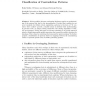Free Online Productivity Tools
i2Speak
i2Symbol
i2OCR
iTex2Img
iWeb2Print
iWeb2Shot
i2Type
iPdf2Split
iPdf2Merge
i2Bopomofo
i2Arabic
i2Style
i2Image
i2PDF
iLatex2Rtf
Sci2ools
GFKL
2006
Springer
2006
Springer
Classification of Contradiction Patterns
Abstract. Solving conflicts between overlapping databases requires an understanding of the reasons that lead to the inconsistencies. Provided that conflicts do not occur randomly but follow certain regularities, patterns in the form of "If condition Then conflict" provide a valuable means to facilitate their understanding. In previous work, we adopt existing association rule mining algorithms to identify such patterns. Within this paper we discuss extensions to our initial approach aimed at identifying possible update operations that caused the conflicts between the databases. This is done by restricting the items used for pattern mining. We further propose a classification of patterns based on mappings between the contradicting values to represent special cases of conflict generating updates. 1 Conflicts in Overlapping Databases Many databases exist with overlaps in their sets of represented real-world entities. There are different reasons for these overlaps, like:
| Added | 23 Aug 2010 |
| Updated | 23 Aug 2010 |
| Type | Conference |
| Year | 2006 |
| Where | GFKL |
| Authors | Heiko Müller, Ulf Leser, Johann Christoph Freytag |
Comments (0)

